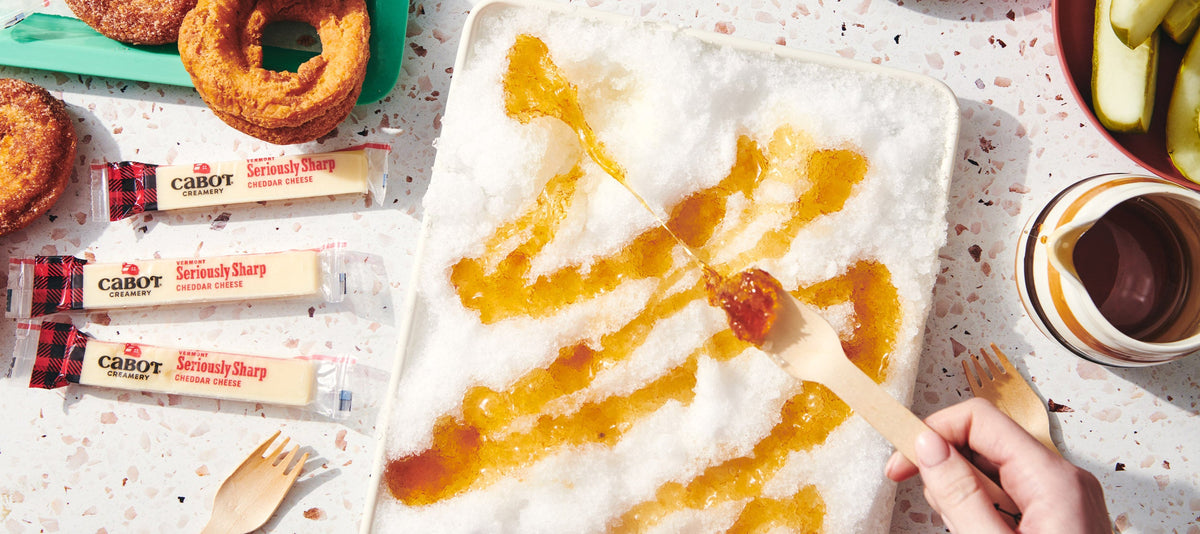
Sugar on Snow
Here in Vermont, many share fond childhood memories of “Sugar on Snow'' celebrations every spring. Family and friends gather at their sugar shacks tucked away in the woods, which are small cabins where sap is boiled into Vermont’s famous maple syrup.
Sugar on Snow is maple syrup brought up to 235° and then drizzled over packed snow, where it seizes up into a shiny, chewy, almost caramel or taffy-like candy. Most people roll it up onto a popsicle stick or a fork; but don’t be surprised if you see someone pick it up with their fingers and shove it in their mouth. It's that amazing. The good news is you don’t have to go all the way to Vermont to enjoy it (although if you can make it out for Maple Weekend in Vermont, New Hampshire, Connecticut, Maine, or New York, and find a place that does Sugar on Snow, be sure to give it a try!) You can make Sugar on Snow and enjoy it like a Vermonter from the comfort of your own home. And consider yourself lucky, because many sugar shack visits involve a slushy, muddy trek through the woods.
Sugar on Snow is a quintessentially Vermont thing, though it’s enjoyed throughout New England and New York (sometimes with a different name. They call it “Jack candy” in western New York!)
In Vermont, sugaring season usually starts around mid-February or early March when temperatures rise during the day to above freezing and drop back down to freezing at night. The rise in temps creates pressure, which makes the sap flow. For hundreds of years, people have been tapping maple trees as spring rolls in and collecting the sap. Traditionally this is done in a metal bucket; you drill a hole into the tree, tap in a little spigot, and regularly empty the sap collected in the buckets
The sap itself—which is now being bottled as “Maple Water” for sale in some stores—is not the syrup that you drizzle over pancakes. To do that, you need to slowly boil the sap down until it reduces and thickens. If you’re interested in learning more about the process, or even trying it out yourself, check out this great resource for getting started.
Oftentimes, sugar shack owners boil the sap over a big wood fire, a process that lends a deep, rich, smoky flavor to the syrup. A lot of the maple producers in New England and New York, including Cabot Farmers like Richardson Family Farm in Hartland, VT, Five Mile Farm in Lisbon, NY - and many others, maintain that smoky flavor in the processes they’ve adopted, even though they’re often producing on a much larger scale than mom and pop sugar makers who just produce syrup for friends and family.
To make your own Sugar on Snow, you’ll need to start with a few key ingredients & tools:
- REAL maple syrup.
- Fresh, clean snow (if there’s no snow where you are, you can try pulsing some ice in a food process or blender until it’s powdery). Pack it into a shallow baking dish, or for individual servings, in bowls.
- A candy thermometer (If you don't have one, you can try using a meat thermometer.)
- Popsicle sticks, forks…or fingers that don’t mind getting sticky.
- Dill pickles.
- Plain donuts. Store-bought is okay, or you can try making your own baked donuts.
- Cabot cheese!
You may be confused by some of the things listed above. Dill pickles? Donuts? Cheese? What do these things have to do with Sugar on Snow? Well. Everything. The acid of the dill pickles and the buttery-ness of the plain donuts and cheddar cheese are the perfect balance to the sweet and smoky sugar on snow. These foods make the Sugar on Snow experience. It sounds weird, but trust us, these things go together.
Making it is pretty simple. Pour 1-2 cups of maple syrup (a little goes a long way) in a pot (preferably one with high sides, because the syrup will grow as it boils) and bring it to a boil until it is 235°.



If you don’t have a thermometer, you could test it by dropping a bit of the syrup into a glass of cold water. If it balls up, it’s ready.
Then drizzle the hot syrup over the packed snow. It’ll seize up almost immediately.
Use a popsicle stick or fork to twirl it up, serve with pickles, Cabot cheddar and donuts—and enjoy!

If you want to try Cheddar Donuts, which make a nice pairing, we recommend the base recipe of these Pecan & Cheddar Mini Donuts.
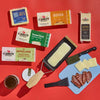


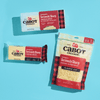
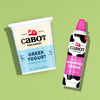
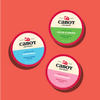
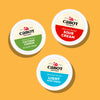
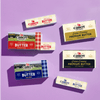
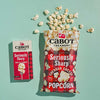
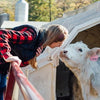
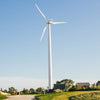



Comments
Marilyn Prior Reickert said:
I enjoyed reading your description of a wonderful childhood memory, "Sugar or snow! My Grandfather always waited for a fresh snowfall, always had to be NEW snow on the undeveloped land on Swift St., Burlington, Vt. and then he would collect it, pack it in pans, boil the syrup and drizzle on the snow as the family would gather to twril our forks and enjoy!
Lisa Terrell said:
My grandparents farm was in Lyndonville, Vermont and my Grandmother always had sour pickles to go with our “sugar on snow”.